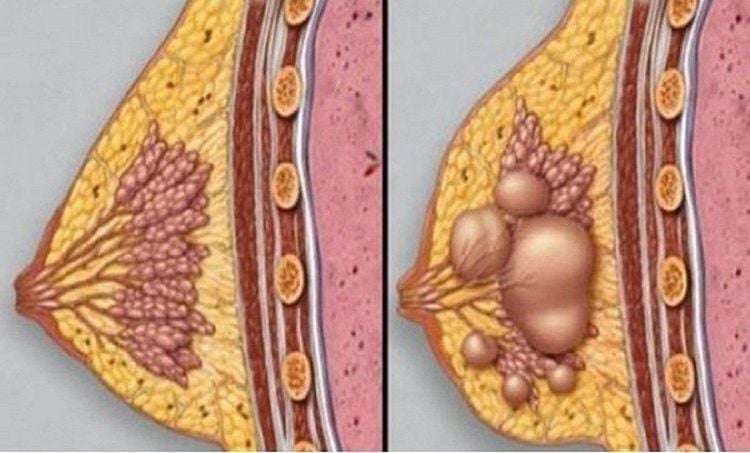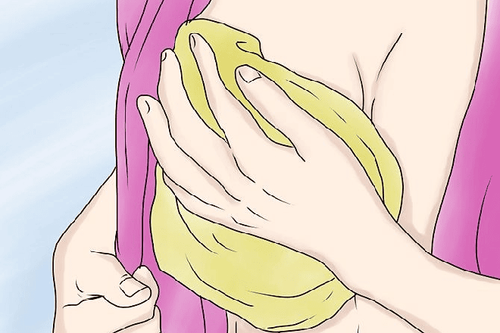This is an automatically translated article.
The article was professionally consulted by Doctor Hoang Thi Anh Tuyet - Department of Obstetrics and Gynecology, Vinmec Central Park International General Hospital.Milk duct obstruction and breast abscess are two very common phenomena encountered in postpartum women and women during lactation. If the milk duct is blocked, it will lead to breast abscess, even breast fibrosis, and infection.
1. Blocked milk ducts
Normally, the milk follicles in the breasts will make milk and then carry the milk through the ducts to the milk-filled sinuses behind the areola. When the baby sucks or has an effect similar to the sucking force of the baby, the milk will flow out. But it may be due to pressure from the outside or some other reason that causes the milk ducts to be blocked inside, making the milk unable to escape, or out in a very small amount. This is called blocked milk ducts.
Blocked milk ducts can happen at any time during breastfeeding, especially in the first few days after birth. Manifestations of blocked milk ducts include:
Breasts are tight, hard, painful, the level is increasing gradually making the mother extremely painful and uncomfortable When touching the breast, you see one or more hard lumps Milk secretes little or not secrete The mother may have a fever Causes of blocked milk ducts :
The milk ducts have not been cleared at the mother's nipples The baby is suckling too little, the excess milk is too much The baby is not suckling properly, causing the nipple damaged, creating conditions for bacteria to penetrate Flat or retracted nipples, making it difficult for the baby to suckle, and at the same time prevent milk from escaping Improper nipple hygiene

Tắc tia sữa có thể xảy ra trong suốt giai đoạn cho con bú
The child's tongue and mouth are not properly cleaned, accidentally causing bacteria from the baby's mouth to attack the nipple. After the baby finishes feeding, there is still a certain amount of excess milk and the mother does not express this amount of milk When the milk duct is blocked The mother needs to breastfeed more often, actively sucking milk to let the milk out. If the condition does not improve, then you should seek the help of professional milk duct unblocking units or go to the hospital for advice from a doctor.
Blocked milk ducts not only cause pain and discomfort to the mother, affect the amount of milk of the baby, make the baby not get enough milk, but also can lead to other dangers such as breast abscess, postpartum depression because of pressure and fatigue due to blocked milk ducts, even infections, which are life-threatening.
2. Breast abscess
Breast abscess is the appearance of inflammatory foci deep inside the mammary gland. These foci of inflammation are caused by bacteria, mainly streptococcus and staphylococcus. Breast abscesses commonly occur in lactating women. Bacteria from the nipple, taking advantage of the wound, follow the milk duct to the inside, causing inflammation of the mammary gland. If not treated in time, it will lead to breast abscess.
When there is an abscess, touching the chest will see a hard lump, inside there is a cyst filled with pus, around the cyst is inflammatory tissue. At the same time, the outer skin at that location will be red and swollen, with a burning sensation. You will feel pain deep inside your chest, which is worse when you touch or move your arm. The breast with the abscess will be enlarged, firm, and axillary lymph nodes will also develop. Breasts do not produce milk or produce very little. An ultrasound will show an area of pus forming at the site of the hard lump. Blood tests showed an increase in leukocytes and erythrocyte sedimentation rate, and the white blood cell count turned to the left.
Usually, people with blocked milk ducts easily turn into breast abscesses. Because the milk stagnates in the breasts for a long time, it cannot escape. In this case, you need to take antibiotics and anti-inflammatory to prevent an infection from developing. If not, it must be combined with puncture to remove pus from the abscess. The abscess will get bigger and bigger, to some extent, it will burst on its own or it can be poked to get the pus out. During that time, the mother will have a feeling of extreme pain, tightness in the chest as if it is about to explode, possibly accompanied by high fever, cold fever all over the body, thirst, dry lips, dirty tongue, pale body, Weakness.... Time to treat breast abscess should not breastfeed because milk may be mixed with pus, in addition, high fever will affect milk quality, breastfed babies are easy to have digestive disorders, diarrhea, loose stools or strange-colored stools... Only breastfeed in the normal breast, and in the breast with abscess, suck the milk away.

Không vệ sinh bầu vú sạch có thể là nguyên nhân dẫn đến áp xê vú
3. How long does it take to get an abscess?
Blocked milk ducts cause milk to stagnate inside the breasts, leading to an abscess for a long time. The average time from blocked milk ducts to blocked milk ducts and turned into abscesses is 4 weeks
Therefore, when you see the phenomenon of blocked milk ducts, the mother should clear the milk as soon as possible. The milk that is passed out will reduce the blockage and limit the possibility of developing an abscess.
Currently, at Vinmec International General Hospital, spinal manipulation method is applied to treat blocked milk ducts after giving birth without using drugs. With the Spinal Impact Method, the treatment technician mainly uses the fingertip software to work on the patient's back spine to adjust and open the milk glands, help clear the rays, and soften the breasts. Therefore, in urgent cases, pregnant women should go to the hospital for timely examination and treatment, to avoid unnecessary complications.
Please dial HOTLINE for more information or register for an appointment HERE. Download MyVinmec app to make appointments faster and to manage your bookings easily.













